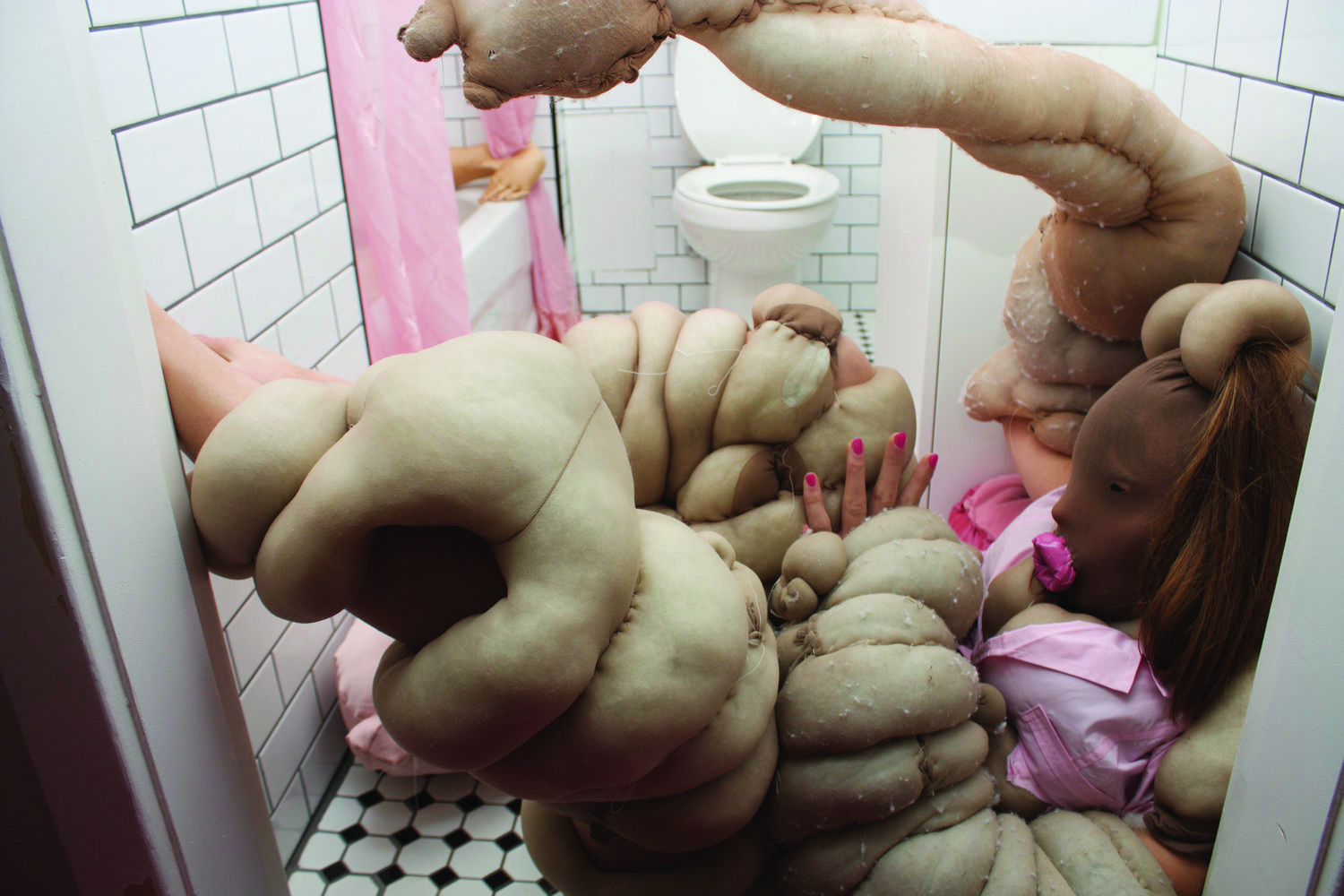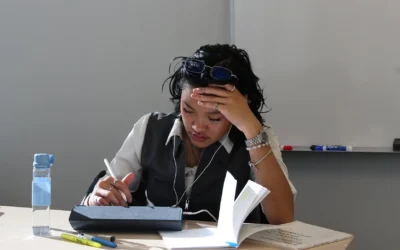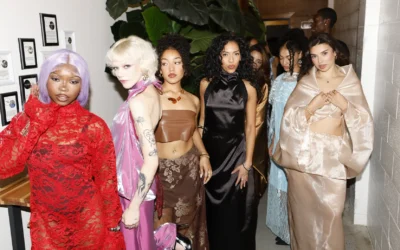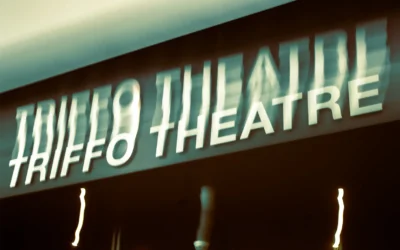I first met Kasie Campbell at Crash Hotel in September of 2017 in what I can confidently call one of the more bizarre nights of my life. It was a event called Crash My Room in which different artists each curated the design of an individual room in the hotel.
I spent the night wandering from room to room, exploring with drunken excitement. Each new door felt like a portal into the mind of the artist and each room was filled to the brim with artistic expression. I went from drinking champagne with homies to having pillow fights with drag queens.
Towards the end of the night, I stumbled upon one doorway which was draped with a pink veil which looked unmistakably like a vagina, and without a second thought, I stepped inside the “womb”. The next moment of my life resembled a scene out of Silent Hill. The walls of the dimly lit inner-vaginal area were covered with a silken fabric and yarn formed a fleshy webbing that hung from the ceiling.
Laying on the bed in the centre of the room was the figure of a woman that appeared to be entombed in a potato-like material. Underneath the lumpy exterior, limbs could be seen, along with nails glowing with a bright pink polish. I then took a seat on the red shag carpet of the vaginal floor, pulled out my camera, and started to document my new strange reality.
The following morning, still in recovery from the surreal experience that was Crash Hotel — I logged into Facebook and found a message waiting for me in my inbox.
The sender stated that a mutual friend had forwarded some of the photos that I had taken of the room she curated and she was wondering if I could send her more of the photos.
It was the woman from the womb. I looked through her posted photos and was so intrigued how someone who looked so normal could have created the surreal visual landscape I had experienced the night before. I replied, “absolutely.” And that was the beginning of my friendship with the artist Kasie Campbell.
A drive for creation was instilled into Campbell at a young age by her mother, who would often paint, crochet, and knit with her. The pair would spend time working together on small projects, and this pastime grew until high school where it was fully realized that art was all that Campbell cared to pursue.
“If you love what you do, success will find you,” her father would remind her. She took this message to heart, and enrolled herself into the Bachelor of Fine Arts program at the University of Alberta.
Campbell initially believed that she wanted to be a painter but soon discovered that it did not give her the same fulfillment that she found in structure — creating imposing forms that were so physically present and objects that demanded space, as well as attention. Her focus then quickly shifted to sculpture, and has since slowly evolved into the pieces that you see today.
The contorted shapes and bulging figures that she fabricates are born in quiet contemplation and then emerge in her studio through countless hours of stitching and sewing. The forms that manifest from the other side of her consciousness bring with them a sense of strange nostalgia — like a twisted memory from a parallel universe.
“I am really drawn to these rich, floral patterns. They’re very nostalgic and they come from a different time. I like to use them because they are relatable to most everyone and can draw in the viewer.
“Pairing/contrasting them with flesh toned nylons also speaks to this kind of transformation of morphing from one thing to another,” says Campbell.
In addition to these otherworldly creations that preoccupy much of her time, Campbell often takes her work to the street as somewhat of an experiment in human psychology. She was recently was asked to fly and bring her performative art project, We Are Revealed to New York in October to be a part of the Art in Odd Places Festival.

“We Are Revealed deals with the anxieties and vulnerabilities that I experience when I’ve become the object of someone else’s gaze,” Campbell explains.
“The costume that is worn for the duration of the performative installation manipulates the emblematic nature of clothing and skin; poetically deeming its own connotations of what is attractive and repulsive. As the work continues to evolve and as I spend more time wearing the costumes, I have come to understand it as a manifestation of my anxieties in physical form.”
Much of Campbell’s identity is embedded in her craft and while it may not be apparent to onlookers, every piece brings the artist closer to her understanding of self as well as identity in the public perspective.
“The work speaks directly to the paradoxical attractions and simultaneous tensions between what could be defined as beautiful or grotesque. The performance utilizes a formula for movement based on personal experience and anxiety in certain social situations. The non-vocal dialogue that occurs between the viewers and the performer is responsible in generating the performance. It relies on the audience; using the spectators as a crutch, which in turn frees myself from any responsibility of my actions,” Campbell says.
Campbell has heads turning wherever she goes and her work has been gaining appreciation internationally. In 2015, Campbell was awarded the Outstanding Student Achievement in Contemporary Sculpture award from the International Sculpture Centre.
Her winning sculpture, Scopophilia, was selected first out of 428 art students nominated from 158 post-secondary schools worldwide, and was featured in the October 2015 issue of Sculpture.
The award has since created many opportunities for Campbell, including being selected for an art residency at the Kennedale Facility, which was supported by the Edmonton Arts Council as well as the City of Edmonton.
Eager to make to use of the new resources and assets that were now available to her, she expanded her reach into the realm of concrete as an experimental medium.
“I learned so much during my residency but there was also a lot of trial and error. Concrete is a strong, industrial material but if it is not mixed properly it becomes very fragile. I played with different additives to make it stronger and experimented with pouring concrete into nylons as well. I was really interested in making shapes that look soft but are in reality very hard,” Campbell says.

After her year-long residency at the Kennedale Facility, Campbell showcased the body of work created during her exhibition Soft/Hard which was housed at Great Western Garment Company building.
The facility has a deep history ingrained within its walls which directly connects with the intention behind the work that she created. For many years the building empowered women in the textile industry in a time where men generally were the main source of familial income.
The feminine perspective is an inherent quality of many of her pieces, as is the theme of connection. Campbell and her daughter Mavi’s contribution to the exhibition Childish, which was recently featured in front of the John and Maggie Mitchell Art Gallery in Allard Hall of MacEwan University was a combination of both of these elements. Campbell initiated a weekly crochet circle where she taught a group of newcomers as well as her daughter the art of crochet while collaborating on a public art piece that steadily evolved over the month of November.
“My mother had recently passed away, so my daughter Mavi and I were very much in that grief-ridden kind of space of constantly thinking about her and missing her,” says Campbell. “As we went through her belongings, we found her yarn and supplies and found ourselves inspired by them. I thought about how my grandmother taught my mother how to crochet and knit, and how my mother then taught me, so I thought this would be a really neat opportunity to teach Mavi how to do the same. A collaboration that has transcended time. It was really all about that connection. We then held weekly crochet circles outside the gallery so that we could continue sharing her passed down skills with the community. It was a very healing time for us in a time where we just wanted to just stay at home all day.”
The mind of Kasie Campbell is a brilliant one and her art is born from the corners of the subconscious where many do not dare to investigate. The manifestations of repressed psychic material that lie just beyond the doors of perception — from the pockets of memory to the obscured anxieties that we all have. Look further, dig deeper, inside and out … and you just catch a glimpse of what has been so apparent to Campbell all along, these visions of beauty in the grotesque.
Photos supplied & by Milo Knauer.





0 Comments